The 7 best live cell imaging solutions include high-speed CMOS cameras for real-time capture at 30 fps, sCMOS systems with 95% quantum efficiency, integrated setups with environmental controls, specialized fluorescence detection cameras, compact time-lapse systems, AI-enhanced tracking technologies, and confocal-ready options for 3D visualization. You’ll benefit from reduced phototoxicity, enhanced sensitivity, and automated data processing. Discover how these advanced systems can transform your understanding of cellular dynamics.
High-Speed CMOS Cameras for Real-Time Cellular Dynamics
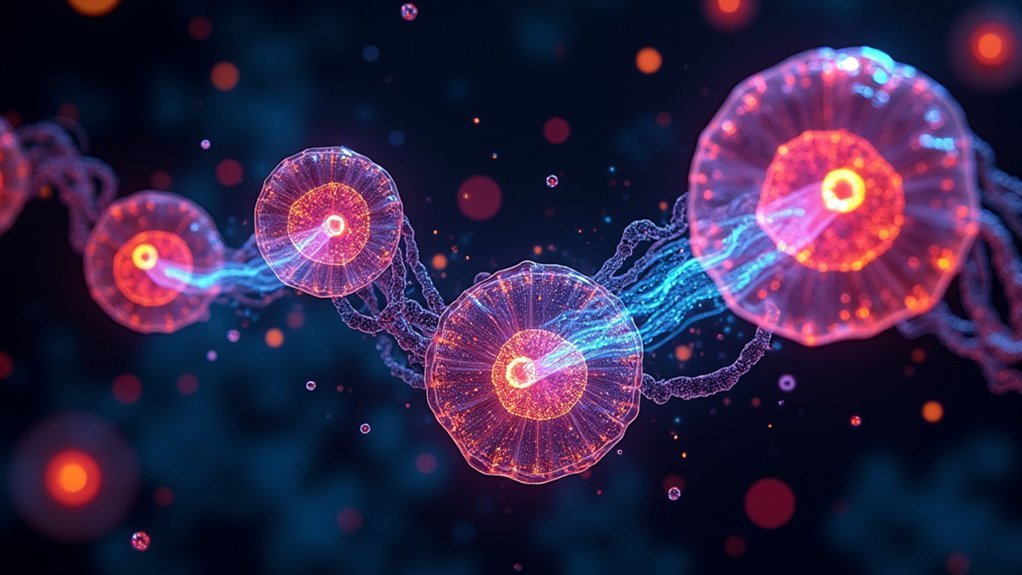
While traditional imaging methods often fail to capture fleeting cellular events, high-speed CMOS cameras have revolutionized live cell imaging by enabling real-time observation at approximately 30 frames per second.
You’ll find these cameras excel in low-light conditions, drastically reducing phototoxicity risks while maintaining ideal cell viability during extended imaging sessions.
The advanced imaging techniques possible with CMOS technology deliver superior signal-to-noise ratios, letting you visualize dynamic cellular processes with unprecedented clarity.
Your image acquisition becomes more efficient, capturing transient phenomena like migration, cytokinesis, and apoptosis as they naturally occur.
When integrated with spinning disk confocal systems, you’ll achieve high-resolution visualization of live cell activities that were previously impossible to document.
This combination of speed and sensitivity makes CMOS cameras indispensable for modern cellular research.
Scmos Camera Systems With Enhanced Sensitivity for Low-Light Conditions
When selecting an sCMOS camera system for your low-light live cell imaging, look for models with optimized quantum efficiency exceeding 95%, which directly translates to clearer images at lower illumination intensities.
You’ll minimize phototoxicity damage to sensitive specimens by capitalizing on the sCMOS’s enhanced sensitivity, allowing for reduced light exposure while maintaining robust signal-to-noise ratios.
Consider complementary data processing solutions that integrate with your camera system, as these can further enhance image quality through real-time noise reduction algorithms and facilitate management of the substantial data volumes generated during extended imaging sessions.
Quantum Efficiency Optimization
Because photons are precious commodities in live cell imaging, sCMOS camera systems have revolutionized the field with their exceptional quantum efficiency rates exceeding 70%.
This optimization allows you to detect even the weakest fluorescence signals emitted by living cells.
You’ll capture dynamic cellular processes in real time thanks to reduced noise levels and faster readout speeds—achieving up to 100 fps for high-speed imaging without sacrificing image quality.
The large sensor area eliminates the tedious task of stitching multiple images together, streamlining your workflow.
Advanced cooling technologies further enhance your imaging capabilities by minimizing thermal noise, enabling longer exposure times when needed.
This thorough quantum efficiency optimization guarantees you’ll document subtle cellular behaviors that would otherwise remain invisible with conventional imaging systems.
Reduced Phototoxicity Imaging
The greatest challenge in live cell imaging isn’t just capturing clear images—it’s keeping your specimens alive and functioning naturally throughout observation. sCMOS camera systems with enhanced sensitivity directly address this fundamental concern through their exceptional performance in low-light conditions.
When you’re conducting long-term imaging, reduced phototoxicity becomes critical. The advanced pixel architecture of sCMOS cameras delivers superior imaging sensitivity while requiring less intense illumination.
You’ll benefit from rapid imaging speeds up to 30 FPS, allowing you to observe dynamic cellular processes without compromising cell viability. Pair these systems with longer wavelength fluorescent reagents for further protection of your specimens.
This live-cell imaging technology guarantees your research captures authentic cellular behavior by maintaining cellular integrity throughout extended observation periods—essential for meaningful scientific discoveries.
Data Processing Solutions
Handling the massive data streams generated during live cell imaging requires powerful processing solutions that match your sCMOS camera system’s capabilities.
These advanced systems offer exceptional sensitivity for capturing even the faintest fluorescence signals in your specimens, with wide dynamic ranges that preserve detail across varying intensities.
- Integrate your sCMOS camera systems with specialized software for streamlined data acquisition and analysis of complex datasets
- Leverage real-time processing features to receive immediate feedback during experiments, allowing you to adjust parameters on-the-fly
- Take advantage of high quantum efficiency sensors to detect subtle cellular changes in low-light conditions
- Utilize automated analysis tools to extract meaningful insights from the wealth of information your cell imaging systems generate
With these data processing solutions, you’ll transform raw imaging data into valuable scientific insights efficiently.
Integrated Microscope Camera Solutions With Environmental Controls
Successful live cell imaging depends on sophisticated systems that integrate cameras with environmental controls. When you’re monitoring cellular processes, maintaining ideal gas mixtures, temperature, and humidity becomes vital for preserving cell viability during experiments.
Solutions like the Incucyte Live-Cell Analysis Systems offer real-time monitoring capabilities that let you track cellular activities while maintaining precise environmental conditions.
You’ll find both stage-top incubators and larger enclosure systems from third-party manufacturers that guarantee stable environments for long-term imaging.
The integration of advanced imaging techniques with environmental control systems greatly reduces phototoxicity, allowing you to conduct extended observations without compromising cell health.
This combination enhances data reliability and quality, making it possible to capture authentic cellular behavior under physiologically relevant conditions.
Specialized Fluorescence Detection Cameras for Multi-Channel Imaging
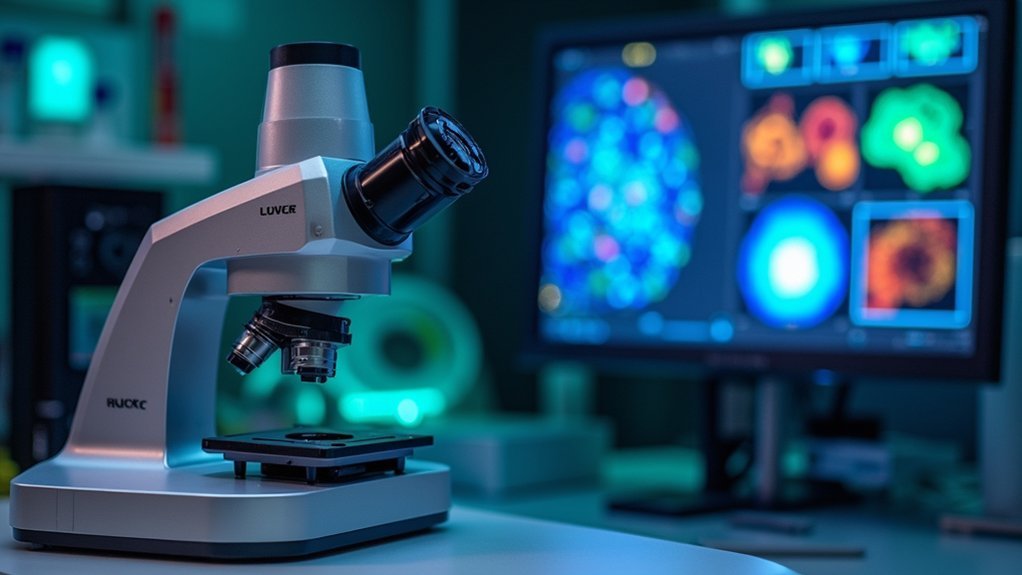
Advanced fluorescence detection cameras transform multi-channel imaging by enabling you to track multiple cellular processes simultaneously.
These specialized systems feature high-sensitivity sensors that detect even the faintest signals from low-abundance targets in your live-cell imaging experiments.
When selecting fluorescence imaging equipment for your lab, look for:
- High frame rates (30+ FPS) and low readout noise for capturing dynamic cellular processes in real-time
- Compatibility with multiple fluorophores to minimize spectral overlap during complex experiments
- Support for advanced techniques like FRET and FRAP to study molecular interactions
- Integration capabilities with major microscopy platforms (Nikon, Leica) for optimized performance
You’ll find these multi-channel imaging systems indispensable when investigating rapid biological events that require both temporal precision and spectral discrimination.
Compact Time-Lapse Systems for Long-Duration Cell Monitoring
Three key innovations have revolutionized long-duration cell monitoring: automation, environmental control, and non-invasive imaging techniques.
Systems like the BioPipeline LIVE can automate imaging for up to 44 vessels simultaneously, boosting your lab’s efficiency when tracking cellular processes over extended periods.
You’ll find economical options like the Incucyte SX1 that streamline live-cell imaging while maintaining cell health through precise environmental control.
Stage-top incubators guarantee ideal conditions throughout your experiments, which is critical for accurate results.
Advanced fluorescence imaging capabilities, including widefield and TIRF techniques, allow you to observe dynamic cellular activities without compromising viability.
These compact time-lapse systems minimize human error through automation, letting you continuously monitor cells for days or weeks while capturing subtle morphological changes and cellular behaviors in real-time.
AI-Enhanced Camera Technologies for Automated Cell Tracking
AI-enhanced camera technologies now offer you powerful multi-object tracking systems that simultaneously monitor thousands of cells with unprecedented precision and speed.
The latest fluorescence analysis automation eliminates manual image processing, letting you instantly identify specific cellular structures and quantify their dynamic changes across time points.
You’ll discover how advanced cell motility prediction algorithms can anticipate migration patterns, enabling real-time experimental adjustments that dramatically improve research outcomes in drug development and disease modeling.
Multi-Object Tracking Systems
While traditional microscopy often requires manual tracking of cellular movements, modern multi-object tracking systems have revolutionized live cell imaging by automating the simultaneous monitoring of numerous cells with remarkable precision.
You’ll benefit from AI-enhanced camera technologies that deliver real-time tracking at impressive speeds of up to 30 FPS, essential for capturing dynamic cellular interactions.
- Compatible with multiple imaging modalities including fluorescence and brightfield microscopy for versatile research applications
- Integrates seamlessly with environmental control systems to maintain stable physiological conditions during extended imaging sessions
- Achieves high precision detection of individual cells even in dense populations
- Facilitates complex analysis of migration patterns and proliferation rates, advancing both drug discovery and developmental biology research
Fluorescence Analysis Automation
Once limited to manual interpretation and adjustment, fluorescence analysis has undergone a transformative evolution through AI-enhanced camera technologies that automate cell tracking with unprecedented precision.
Fluorescence imaging allows you to monitor dynamic cellular responses in real time while minimizing phototoxicity and photobleaching that typically compromise long-term studies.
With automated cell tracking, imaging has become notably more efficient, reducing the need for constant supervision and eliminating human error. You’ll process vast datasets in minutes rather than hours, extracting meaningful insights from complex cellular interactions.
These AI-enhanced camera technologies refine imaging parameters automatically, ensuring your long-term live-cell imaging experiments maintain ideal conditions for cell viability. By improving the efficiency of data collection and analysis, you’ll achieve more reliable, reproducible results while capturing subtle cellular behaviors that manual methods might miss.
Cell Motility Predictions
Beyond simply tracking cells, today’s AI-enhanced camera systems can accurately predict cellular movement patterns before they occur.
You’ll find these AI-enhanced camera technologies revolutionize your live-cell imaging experiments by eliminating manual errors while dramatically increasing efficiency. When studying dynamic processes like cancer metastasis or wound healing, automated cell tracking delivers precise quantitative metrics on movement parameters.
- Machine learning algorithms predict cell motility in real-time, offering unprecedented insights into cellular behaviors
- Enhanced throughput capabilities allow you to analyze larger, more complex datasets than traditional methods
- Receive detailed measurements of cell speed, directionality, and migration paths automatically
- Improve your research reproducibility with consistent, reliable data collection across biological processes
These advanced systems transform how you observe and understand cellular dynamics, making complex motility studies more accessible and scientifically robust.
Confocal-Ready Camera Options for 3D Live Cell Visualization
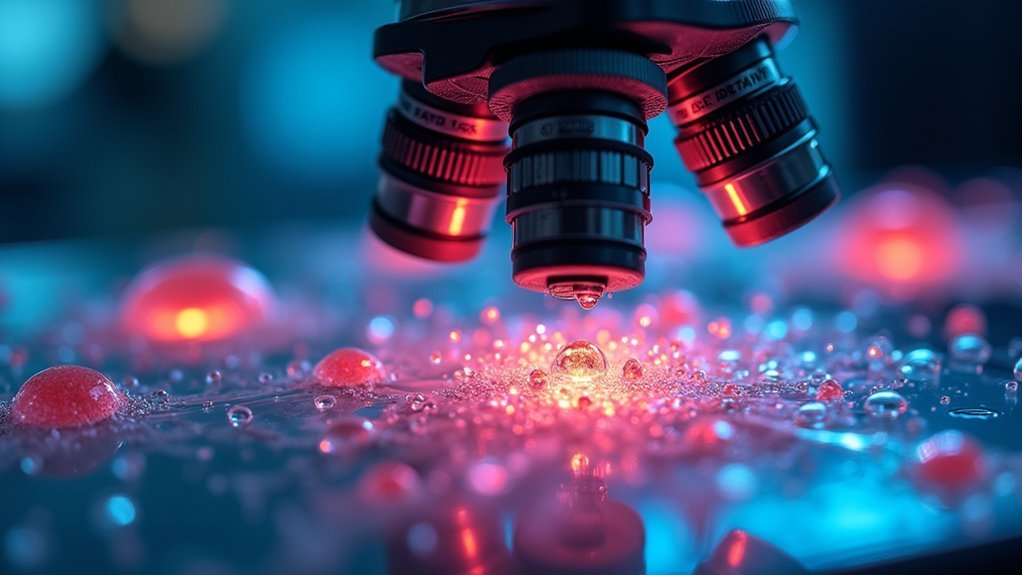
Although traditional microscopy techniques can capture basic cellular structures, confocal-ready camera systems elevate 3D live cell visualization to unprecedented levels of detail and clarity. You’ll find these systems essential when imaging samples thicker than 20 μm, where point-scanning techniques deliver superior resolution.
| System | Key Feature | Best Application |
|---|---|---|
| Yokogawa CSU | Fast acquisition speeds | Dynamic cellular processes |
| ECLIPSE Ti2-E | Perfect Focus System | Long-term studies |
| AI-integrated | Automated data analysis | Complex 3D datasets |
For precise imaging of rapid cellular processes, choose systems offering high-speed acquisition at 30 FPS. The integration of AI-based software tools greatly enhances your ability to process and interpret complex data, making these confocal-ready options invaluable for researchers requiring detailed 3D visualization of living cells.
Frequently Asked Questions
What Microscope Can See Cells?
You can see cells with fluorescence, confocal, or inverted microscopes like the ECLIPSE Ti2-E. Spinning disk confocals such as Yokogawa CSU and KEYENCE’s BZ-X800 are excellent for visualizing living cells.
How Does Live-Cell Imaging Work?
Live-cell imaging works by using specialized microscopes that let you observe cells in real-time while maintaining their viability. You’ll need fluorescent markers to highlight specific structures and environmental controls to keep cells healthy during observation.
What Is the Best Microscope for Live Cells?
For live cell imaging, you’ll find the ECLIPSE Ti2-E with PFS4 prevents focal drift during long experiments. It’s exceptional when paired with Yokogawa spinning disk systems for reduced phototoxicity and fast acquisition.
Which Type of Microscope Is Best for Observing Living Cells?
Confocal microscopes are your best choice for observing living cells. They’ll give you high-resolution images and let you focus on specific depths within samples, which is perfect for detailed cellular studies.
In Summary
You’ve now explored the top 7 live cell imaging solutions, from high-speed CMOS cameras to AI-enhanced tracking systems. Whether you’re monitoring cellular dynamics, capturing fluorescence signals, or creating 3D visualizations, these technologies will elevate your research capabilities. Select the system that matches your specific requirements, and you’ll reveal new possibilities for observing cellular processes with unprecedented clarity and precision.
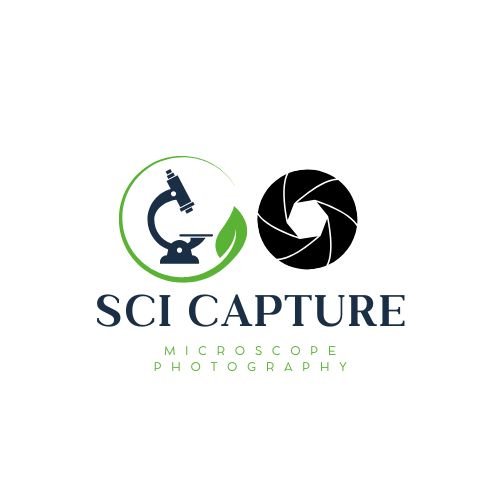

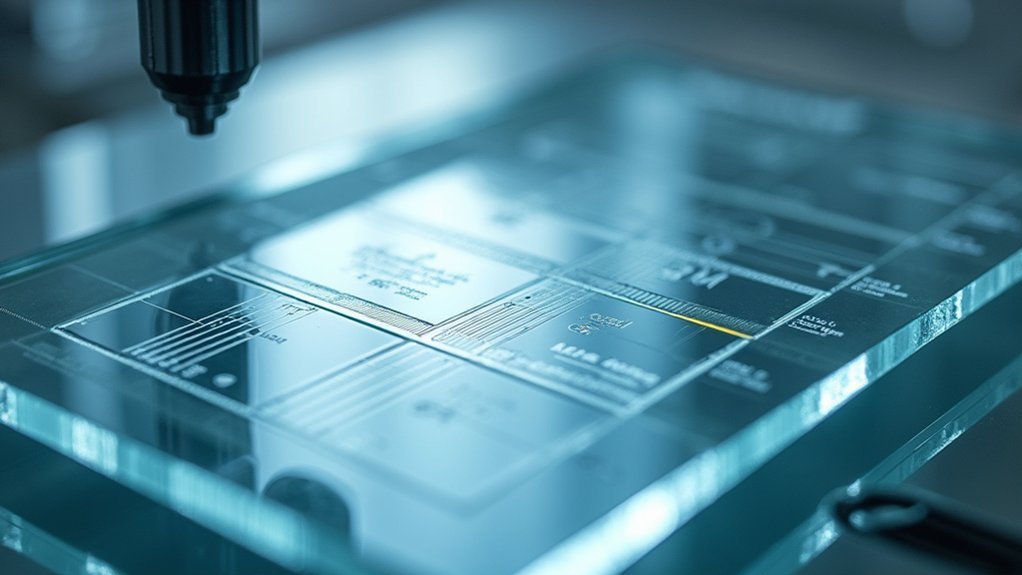


Leave a Reply